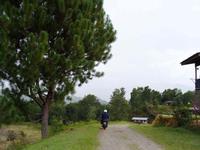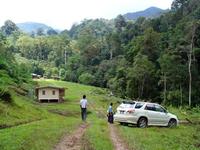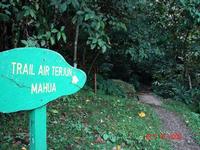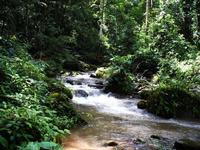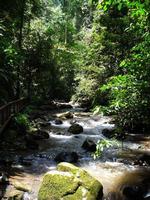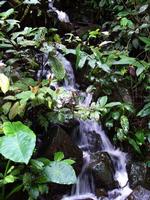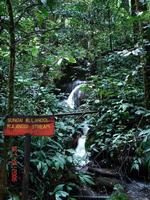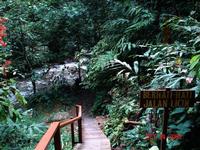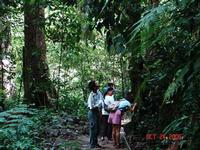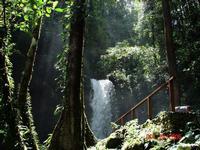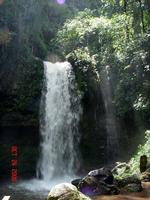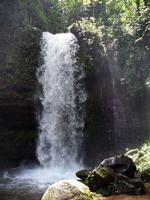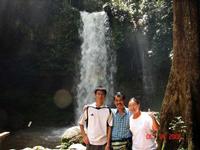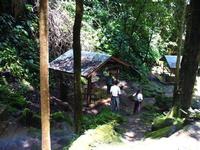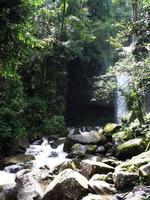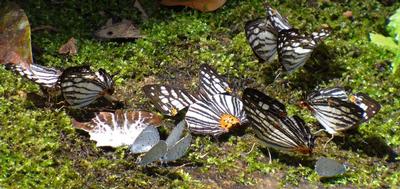 The Villages of Tambunan are nestled in a valley on the interior side of the
The Villages of Tambunan are nestled in a valley on the interior side of the 
Located in Keranaan Village not far from the Township of Tambunan, the Tambunan Village Homestay Programhas 10 participating families, all certified by the Malaysia
Ministry of Tourism.
The program is coordinated by Joanna Kitingan, and is closely linked to the Tambunan Valley Resort Centre (TVRC).
Tambunan Village Homestay Program offers unique live-in experiences for visitors to stay with a local hostfamily in their home. This means participants will eat locally cooked meals (mostly traditional ingredients), and learn to live like the locals.
The participating Homestay Host Families will provide a spare rooms for guests in their homes, whereby bathroom facilities are usually shared with the host family.
Programs can be tailor made to suit different groups interests and available time. Two potential "mock-up"programs.
 Some of the view of Tambunan
Some of the view of Tambunan Padi field known as Tabasan..
Padi field known as Tabasan.. some of the paddy. baru sija kana tanam..isn't beauty??
some of the paddy. baru sija kana tanam..isn't beauty?? see, enjoy bah mereka..huhu
see, enjoy bah mereka..huhu Activities
ActivitiesThe Following Activities can be incorporated into the
homestay programs at Tambunan Village Homestay.
- Planting or Harvesting in Rice Fields
- Traditional Rice Wine Making
- Riding buffalo
- Traditional Cooking
- Harvesting Forest Vegetables
- Visit Local Markets
- Visit Local Bamboo Factory
- Jungle Trekking
- Observing worlds largest flower Rafflesia
- Swimming in cool mountain streams
- Traditional music & dance performances
 Kulabut market ( the Tuhau Centre)
Kulabut market ( the Tuhau Centre) Jambatan gantung
Jambatan gantung momonsoi bangkala (traditional Fish Trap)
momonsoi bangkala (traditional Fish Trap) Playing Gongs
Playing Gongs yeah, finally i can sense the Tuhau
yeah, finally i can sense the Tuhau kihoi..aramai tii..makan ramai2,
kihoi..aramai tii..makan ramai2,
Day 1
Arrived at Kg. Keranaan & traditional welcoming
Meet host family
Visit to bamboo factory
Visit TVRC for fish feeding
Join the Cultural Dance (for Min 30 pax only)
Dinner with host family (D)
Day 2
Break Fast with host family (B)
Visit the Tambunan Town, Market, & Gong Stone
Visit No. 1 Lihing (Rice Wine) Factory
Lunch with host family (L)
Farewell Party & give appreciation
Back to Kota Kinabalu
RATE AS PER ABOVE ITINERARY (2D1N):
RM120.00 PER PERSON (MIN. 30 PAX)
3D/2N PROGRAM (Package)
Day 1
Arrived at Kg. Keranaan Walai Tokou meeting point
Traditional welcoming & meet host family
Visit to the Bamboo Factory (Making)
Visit TVRC fish feeding
Dinner with host family (D)
Getting to know family history and History of Tambunan
Day 2
Break Fast with host family (B)
Jungle upstream trekking to Tandarason,
Enjoy a cool swim
Enjoy drinking water from tree and bamboos
Picnic lunch by the clear stream
Dinner with host family (D)
Join the Cultural Dance (for min. 30 pax only)
Day 3
Break Fast with host family (B)
Visit the Tambunan Town, Market, & Gong Stone
Visit No. 1 Lihing (Rice Wine) Factory
Lunch with host family (L)
Farewell Party & give appreciation
Back to Kota Kinabalu
RATE AS PER THE ABOVE ITINERARY (3D2N):
RM240.00 PERSON (MIN. 30 PAX)
Contact details,
Email Contact 2: avanus7@yahoo.com
Postal Address: Tambunan Village Homestay
C/ G192 Lorong Cempaka
KG.Contoh Petagas
88200 KOTA KINABALU
Home Tel : +60 88 764052
H/P (Mobile): +60 14 3580853 / +60 14 6555043
Fax : +60 88 230714

